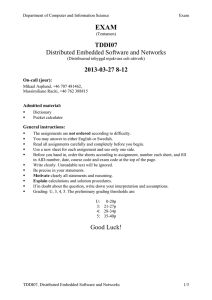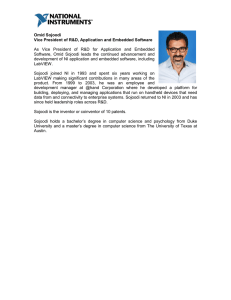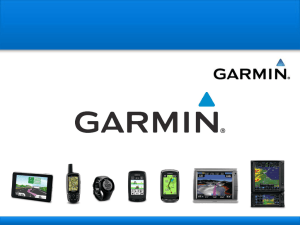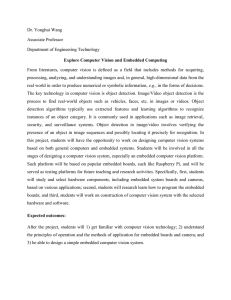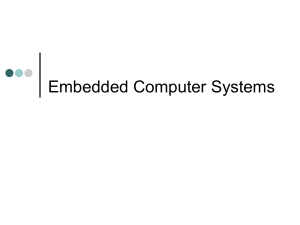TDDI11: Embedded Software Embedded Systems Design
advertisement
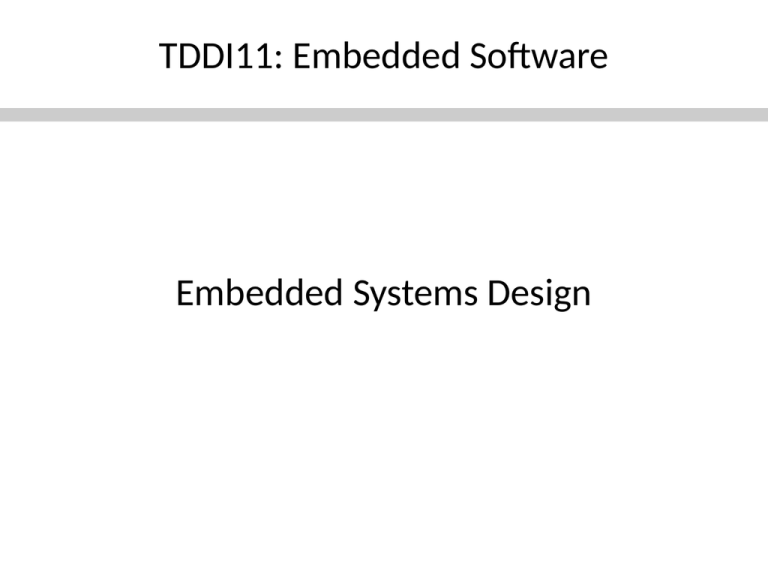
TDDI11: Embedded Software Embedded Systems Design Design challenge – optimizing design metrics • Common metrics – Unit cost: the monetary cost of manufacturing each copy of the system, excluding NRE cost – NRE cost (Non-Recurring Engineering cost): The one-time monetary cost of designing the system – Size: the physical space required by the system – Performance: the execution time or throughput of the system – Power: the amount of power consumed by the system – Flexibility: the ability to change the functionality of the system without incurring heavy NRE cost Design challenge – optimizing design metrics • Common metrics (continued) – Time-to-prototype: the time needed to build a working version of the system – Time-to-market: the time required to develop a system to the point that it can be released and sold to customers – Maintainability: the ability to modify the system after its initial release – Safety: absence of catastrophic consequences on the user(s) and the environment. Design metric competition: improving one may worsen others Power Performance Size NRE cost Design methodology, design flow • Design methodology: the process of creating a system – Goal: optimize competing design metrics • • • • Time-to-market Design cost Manufacturing cost Quality, etc. • Design flow: sequence of steps in a design methodology. – May be partially or fully automated. – Use tools to transform, verify design. • Design flow is one component of design methodology. Methodology also includes management, organization, etc. Waterfall model • Early model for software development: requirements/ specification architecture coding testing maintenance Design flows for embedded systems • Embedded systems need design of hardware and software • Even if you don’t design hardware, you still need select the correct boards, plug together several hardware components, and write code Hardware/software design flow requirements and specification architecture software design hardware design integration testing Hierarchical design Frequency of faults Other 10% 7% Code Design Requirements 56% 27% [Jim Cooling 2003, cited from DeMarco78] Specification • Describing embedded system’s behavior – Can be extremely difficult • Complexity increasing with increasing IC capacity • Desired behavior often not fully understood in beginning • English (or other natural language) common starting point – Precise description difficult to impossible • Überlingen crash example Models and languages • How can we (precisely) capture behavior? – We may think of languages (C, C++), but computation model is the key • Common computation models: – Sequential program model • Statements, rules for composing statements, semantics for executing them – State machine model • For control dominated systems, monitors control inputs, sets control outputs – Dataflow model • For data dominated systems, transforms input data streams into output streams Reuse: platforms • A partial design: – – – – for a particular type of system; includes embedded processor(s); may include embedded software; customizable to a customer’s requirements: • software; • component changes. IBM CoreConnect Why platforms? • Any given space has a limited number of good solutions to its basic problems. • A platform captures the good solutions to the important design challenges in that space. • A platform reuses architectures. Standards and platforms • Many high-volume markets are standards-driven: – wireless; – multimedia; – networking. MPEG Tampere meeting • Standard defines the basic I/O requirements. bluetooth.com Standards and platforms, cont’d. • Systems house chooses implementation of standards functions: – improved quality, lower power, etc. • Product may be differentiated by added features: – cell phone user interface. • Standards encourage platform-based design. Platforms and embedded computing • Platforms rely on embedded processors: – can be customized through software; – can put considerable design effort into the CPU. • Many platforms are complex heterogeneous multiprocessors. Agere StarPro 17 Two phases of platform-based design • Design the platform. requirements • Use the platform. past designs platform user needs product Design example

